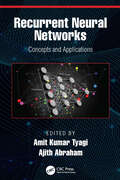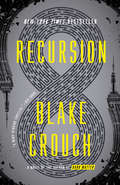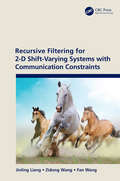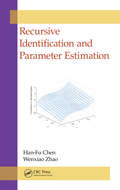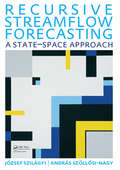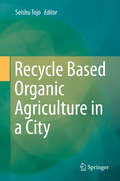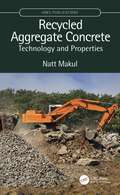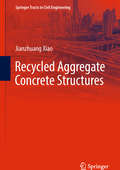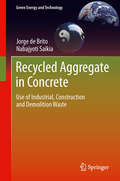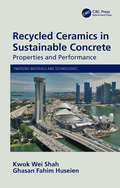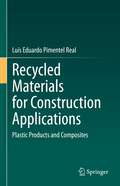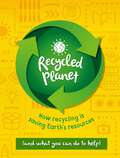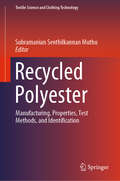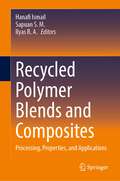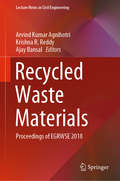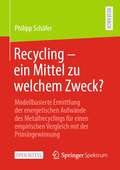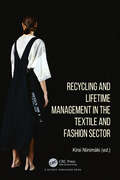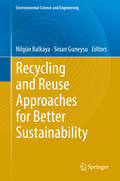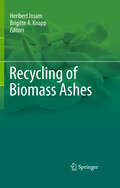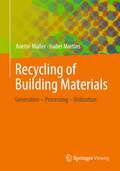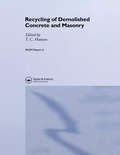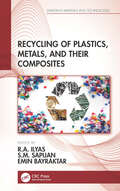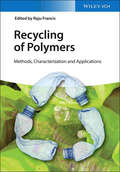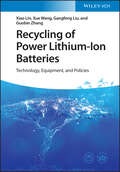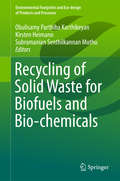- Table View
- List View
Recurrent Neural Networks: Concepts and Applications
by Amit Kumar Tyagi Ajith AbrahamThe text discusses recurrent neural networks for prediction and offers new insights into the learning algorithms, architectures, and stability of recurrent neural networks. It discusses important topics including recurrent and folding networks, long short-term memory (LSTM) networks, gated recurrent unit neural networks, language modeling, neural network model, activation function, feed-forward network, learning algorithm, neural turning machines, and approximation ability. The text discusses diverse applications in areas including air pollutant modeling and prediction, attractor discovery and chaos, ECG signal processing, and speech processing. Case studies are interspersed throughout the book for better understanding. FEATURES Covers computational analysis and understanding of natural languages Discusses applications of recurrent neural network in e-Healthcare Provides case studies in every chapter with respect to real-world scenarios Examines open issues with natural language, health care, multimedia (Audio/Video), transportation, stock market, and logistics The text is primarily written for undergraduate and graduate students, researchers, and industry professionals in the fields of electrical, electronics and communication, and computer engineering/information technology.
Recursion: A Novel
by Blake CrouchFrom the New York Times bestselling author of Dark Matter and the Wayward Pines trilogy comes a relentless thriller about time, identity, and memory—his most ambitious, mind-boggling, irresistible work to date. <P><P>Memory makes reality. That’s what New York City cop Barry Sutton is learning as he investigates the devastating phenomenon the media has dubbed False Memory Syndrome—a mysterious affliction that drives its victims mad with memories of a life they never lived. <P><P>Neuroscientist Helena Smith already understands the power of memory. It’s why she’s dedicated her life to creating a technology that will let us preserve our most precious moments of our pasts. If she succeeds, anyone will be able to re-experience a first kiss, the birth of a child, the final moment with a dying parent. <P><P>As Barry searches for the truth, he comes face-to-face with an opponent more terrifying than any disease—a force that attacks not just our minds but the very fabric of the past. And as its effects begin to unmake the world as we know it, only he and Helena, working together, will stand a chance at defeating it. <P><P>But how can they make a stand when reality itself is shifting and crumbling all around them? <P><b>A New York Times Bestseller</b>
Recursive Filtering for 2-D Shift-Varying Systems with Communication Constraints
by Jinling Liang Zidong Wang Fan WangThis book presents up-to-date research developments and novel methodologies regarding recursive filtering for 2-D shift-varying systems with various communication constraints. It investigates recursive filter/estimator design and performance analysis by a combination of intensive stochastic analysis, recursive Riccati-like equations, variance-constrained approach, and mathematical induction. Each chapter considers dynamics of the system, subtle design of filter gains, and effects of the communication constraints on filtering performance. Effectiveness of the derived theories and applicability of the developed filtering strategies are illustrated via simulation examples and practical insight. Features:- Covers recent advances of recursive filtering for 2-D shift-varying systems subjected to communication constraints from the engineering perspective. Includes the recursive filter design, resilience operation and performance analysis for the considered 2-D shift-varying systems. Captures the essence of the design for 2-D recursive filters. Develops a series of latest results about the robust Kalman filtering and protocol-based filtering. Analyzes recursive filter design and filtering performance for the considered systems. This book aims at graduate students and researchers in mechanical engineering, industrial engineering, communications networks, applied mathematics, robotics and control systems.
Recursive Identification and Parameter Estimation
by Han-Fu Chen Wenxiao ZhaoRecursive Identification and Parameter Estimation describes a recursive approach to solving system identification and parameter estimation problems arising from diverse areas. Supplying rigorous theoretical analysis, it presents the material and proposed algorithms in a manner that makes it easy to understand-providing readers with the modeling and
Recursive Streamflow Forecasting: A State Space Approach
by Jozsef Szilagyi Andras Szollosi NagyThis textbook is a practical guide to real-time streamflow forecasting that provides a rigorous description of a coupled stochastic and physically based flow routing method and its practical applications. This method is used in current times of record-breaking floods to forecast flood levels by various hydrological forecasting services. By knowing
Recycle Based Organic Agriculture in a City
by Seishu TojoThis book highlights the significance of urban agricultural production, the technologies and methods for supplying organic materials to the farmland, recovering plant nutrients and energy in cities, and systems for sustaining farmlands in order to produce agricultural crops and supply safe food to citizens. Focusing on the effective recycling of biomass waste generated in cities for use in organic farming, it discusses alternatives to traditional composting, such as carbonizing organic waste, which not only produces recyclable materials but also converts organic waste into energy. Recycling discarded organic matter appropriately and reusing it as both material and energy is the basis of new urban organic farming, and represents a major challenge for the next generation of urban agriculture. As such, the book presents advanced research findings to facilitate the implementation of safe, organic agricultural production with only a small environmental load.
Recycled Aggregate Concrete: Technology and Properties (IOM3 Publications)
by Natt MakulRecycled Aggregate Concrete (RAC) as a sustainable material is gaining increasing importance in the construction industry. This book discusses properties, specifications, and applications of RAC and offers readers insight into current research and advances in the development and utilization of RAC. It shares information gathered about concretes that use RCA (Recycled Concrete Aggregate, a component of RAC), as well as findings and conclusions. This book: • Presents principles of RAC, including theories and experiments • Describes advanced behavior and properties • Covers specifications and codes • Highlights best practices • Summarizes the use of RAC in sustainable concrete construction • Features scientific findings, citations of reliable sources, conclusions, and recommendations that ensure the book is accessible to various levels of expertise This book will be useful for researchers, concrete scientists, technologists, practicing engineers, and advanced students interested in reusing construction waste for sustainable construction practices; it will help them strive toward meeting the UN Sustainable Development Goals (SDGs).
Recycled Aggregate Concrete Structures
by Jianzhuang XiaoThis book describes how, given the global challenge of a shortage of natural resources in the 21st century, the recycling of waste concrete is one of the most important means of implementing sustainable construction development strategies. Firstly, the book presents key findings on the micro- and meso-structure of recycled aggregate concrete (RAC), while the second part focuses on the mechanical properties of RAC: the strength, elastic modulus, Poisson's ratio, stress-strain curve, etc. The third part of the book explores research on the durability of RAC: carbonization, chloride penetration, shrinkage and creep. It then presents key information on the mechanical behavior and seismic performance of RAC elements and structures: beams, columns, slabs, beam-column joints, and frames. Lastly, the book puts forward design guidelines for recycled aggregate concrete structures. Taken as a whole, the research results - based on a series of investigations the author has conducted on the mechanical properties, durability and structural performance of recycled aggregate concrete (RAC) over the past 10 years - demonstrate that, with proper design and construction, it is safe and feasible to utilize RAC structures in civil engineering applications. The book will greatly benefit researchers, postgraduates, and engineers in civil engineering with an interest in this field.
Recycled Aggregate in Concrete
by Nabajyoti Saikia Jorge De BritoConcrete is the most used man-made material in the world since its invention. The widespread use of this material has led to continuous developments such as ultra-high strength concrete and self-compacting concrete. Recycled Aggregate in Concrete: Use of Industrial, Construction and Demolition Waste focuses on the recent development which the use of various types of recycled waste materials as aggregate in the production of various types of concrete. By drawing together information and data from various fields and sources, Recycled Aggregate in Concrete: Use of Industrial, Construction and Demolition Waste provides full coverage of this subject. Divided into two parts, a compilation of varied literature data related to the use of various types of industrial waste as aggregates in concrete is followed by a discussion of the use of construction and demolition waste as aggregate in concrete. The properties of the aggregates and their effect on various concrete properties are presented, and the quantitative procedure to estimate the properties of concrete containing construction and demolition waste as aggregates is explained. Current codes and practices developed in various countries to use construction and demolition waste as aggregates in concrete and issues related to the sustainability of cement and concrete production are also discussed. The comprehensive information presented in Recycled Aggregate in Concrete: Use of Industrial, Construction and Demolition Waste will be helpful to graduate students, researchers and concrete technologists. The collected data will also be an essential reference for practicing engineers who face problems concerning the use of these materials in concrete production.
Recycled Ceramics in Sustainable Concrete: Properties and Performance (Emerging Materials and Technologies)
by Kwok Wei Shah Ghasan Fahim HuseienRecycled Ceramics in Sustainable Concrete: Properties and Performance explores the use of novel waste materials in the construction industry as sustainable and environmentally friendly alternatives to traditional cement production technologies. It specifically focuses on using waste ceramics as a binder and aggregate replacement for concrete. Includes a lifecycle assessment Describes recycling of ceramic tile waste as fine and coarse aggregate replacement Discusses microstructure performance of sustainable concrete Evaluates performance of sustainable concrete exposed to elevated temperatures and corrosives Written for materials, chemical, and civil engineers as well as others who develop construction materials, this book provides readers with a thorough understanding of the merits of using waste ceramics to produce sustainable concrete. .
Recycled Materials for Construction Applications: Plastic Products and Composites
by Luís Eduardo RealThis book presents the state of the art on the topic of recycling of plastic building materials, comprising a synthetic market analysis, and presenting the latest developments in plastic recycling technologies. The book also makes recommendations to optimize the success of recycling and encourage the circular economy, while acknowledging the environmental and sustainability implications of plastic recycling for building construction. The distinctive features of this book are the variety of topics covered on sustainable plastic recycling, the discussion of advances in plastic recycling technology, detailed illustrations, and summarized descriptions of separation processes. This book is a guide for both technical and non-technical readers, and for anyone involved in plastic waste or recycling, including researchers and students in plastics engineering, polymer science, polymer chemistry, environmental science, and sustainable materials.
Recycled Planet
by Anna ClaybourneRecycled Planet explains to young readers how essential recycling is in today's worldRecycling is part of everyday life today. From food scraps to mobile phones, recycling gives many materials a new lease of life and prevents them from polluting our planet, as well as saving energy.Recycled Planet explores the world of recycling, looking at what we recycle, how it is collected and separated and what happens during the recycling process. It also looks at new forms of recycling, from deposit schemes to repurposing, and assesses some innovations designed to make recycling more global and efficient. Simple activities encourage readers to take part in recycling themselves and to aim to recycle even more!Following on from Plastic Planet and Hot Planet, Recycled Planet will feature the same blend of illustrations and photos and a striking cover, and is written by the award-winning science author Anna Claybourne.Aimed at readers aged 9 plus.
Recycled Polyester: Manufacturing, Properties, Test Methods, and Identification (Textile Science and Clothing Technology)
by Subramanian Senthilkannan MuthuThis book provides an overview of recycled polyesters, which are an important sustainable raw material in textile production. It discusses the manufacturing methods and the unique properties of recycled polyesters manufactured using the different methods. It also highlights the various test methods and identification mechanisms for recycled polyesters, which are very essential for ensuring the traceability and conformity of usage of recycled polyester in the final product.
Recycled Polymer Blends and Composites: Processing, Properties, and Applications
by Hanafi Ismail Sapuan S. M. Ilyas R. A.This book presents an authoritative account of the potential of recycled polymer blends and composites such as recycled rubber, Polypropylene, Poly(Vinylidene Fluoride) (PVDF), polyhydroxybutyrate-3-valerate (PHBV), Polyethylene, and similar compounds, in polymer recycling industries. It highlights the latest research on fundamentals of recycled polymer blends and composites such as physical, chemical, mechanical and thermal properties and morphological studies. The book also provides a comprehensive state of the art review of recycling of polymer blends and composites for sustainability. Polymeric substances recycled from excess sludge in wastewater treatment plants, reinsertion of Poly(Vinylidene Fluoride) (PVDF), polyolefin and Polypropylene post-Industrial waste by primary recycling, as well as the recent development of biomass and COVID-19 plastic waste derived char filled natural starch biocomposite briquettes are also covered.
Recycled Waste Materials: Proceedings of EGRWSE 2018 (Lecture Notes in Civil Engineering #32)
by Arvind Kumar Agnihotri Krishna R. Reddy Ajay BansalThis volume contains selected papers presented during the International Conference on Environmental Geotechnology, Recycled Waste Material and Sustainable Engineering (EGRWSE-2018). The papers focus on finding innovative ways of recycling and reusing waste materials, reducing demand for natural resources and processing industrial and chemical wastes such that disposal reduces their environmental burden. This volume will be of interest to researchers, policy makers and practitioners working in the field of waste management.
Recycling – ein Mittel zu welchem Zweck?: Modellbasierte Ermittlung der energetischen Aufwände des Metallrecyclings für einen empirischen Vergleich mit der Primärgewinnung
by Philipp SchäferIn diesem Open-Access-Buch kritisiert Philipp Schäfer die Entwicklung der Circular Economy hin zu einem Selbstzweck. Um den Beitrag der Circular Economy zu einer nachhaltigen Entwicklung zu gewährleisten, muss sie stets Mittel zum Zweck sein und bedarf daher konkreter Zielsetzungen. Anhand eines ausführlichen Exkurses in die Fachliteratur zeigt der Autor, dass das primäre Ziel der Circular Economy keineswegs durch das Narrativ der schwindenden Ressourcen bestimmt werden sollte. Vielmehr sollte das Ziel die Minderung des Energieaufwands der Rohstoffbereitstellung und der damit verbundenen Treibhausgasemissionen sein. Anhand konkreter empirischer Beispiele zeigt der Autor auf, dass diese konzeptionelle Zielausrichtung zwingend notwendig ist, damit der Beitrag der Circular Economy zum Klimaschutz und damit zu einer nachhaltigen Entwicklung sichergestellt werden kann.
Recycling and Lifetime Management in the Textile and Fashion Sector
by Niinimäki KirsiThis book provides a wide landscape for recycling and product lifetime management in the textile and fashion sector. Through this approach, the book attempts to deepen the understanding of the sustainability transformation, which is currently desperately needed but also already happening in the design, manufacture, consumption and recycling of textiles and garments. The textile and garment recycling and redefining product lifetimes of this transformation are at the core of the new understanding of sustainability. An accessible and compelling read, Recycling and Lifetime Management in the Textile and Fashion Sector will appeal to students, scholars, professionals, policy makers and industry practitioners.
Recycling and Reuse Approaches for Better Sustainability (Environmental Science and Engineering)
by Sinan Guneysu Nilgün BalkayaThis book covers the latest in recycling and reuse research focused toward greater sustainability and includes chapters authored by the world’s leading thinkers and practitioners in the field. Topics covered include recycling and reuse, solid waste management, renewable energy, environmental studies, and wastewater management. This text contains environmental issues with an experimental focus, making this a useful resource to students, researchers, and professionals working in solid waste management, energy and water sustainability issues within the geoscience, engineering, and chemistry fields.
Recycling of Biomass Ashes
by Heribert Insam Brigitte A. KnappThe use of renewable bioenergy is increasing, and so is the production of associated wastes: biomass ashes. This book presents eleven chapters on the options for recycling such biomass ashes, ranging from their use as fertilizer in agriculture and forestry to their application as a supplement for the production of cement-based materials or bricks. The book also examines the pros and cons for each of the different uses of biomass ashes.
Recycling of Building Materials: Generation - Processing - Utilization
by Anette Müller Isabel MartinsThe need to establish material cycles in the building industry is undisputed. Knowledge on this topic is available in many places: In this book it is summarised and systematized. After a general overview of the quantities generated, recovery rates and areas of application of recycled building materials, the current processing steps on which recycling is based and the possibilities for influencing the product properties are discussed. Furthermore, recycling building materials are characterized and their fields of application are presented. The starting point is always the original building material, which is later found in the construction waste. The focus is on the structural properties. The environmental aspects, which have determined the discussion for years, are shown to the necessary extent. The book concludes with a chapter that presents new developments in processing technologies and analyses the potential of construction waste as a source of raw materials.
Recycling of Demolished Concrete and Masonry
by T. C. HansenThis new RILEM report contains state-of-the-art reviews on three topics: recycling of demolished concrete, recycling of masonry rubble and localized cutting by blasting of concrete. It has been compiled by an international RILEM Committee and draws on research and practical experience worldwide.
Recycling of Plastics, Metals, and Their Composites (Emerging Materials and Technologies)
by R. A. IlyasHaving a solid understanding of materials recycling is of high importance, especially due to the growing use of composites in many industries and increasingly strict legislation and concerns about the disposal of composites in landfills or by incineration. Recycling of Plastics, Metals, and Their Composites provides a comprehensive review of the recycling of waste polymers and metal composites. It provides the latest advances and covers the fundamentals of recycled polymers and metal composites, such as preparation, morphology, and physical, mechanical, thermal, and flame-retardancy properties. FEATURES Offers a state-of-the-art review of the recycling of polymer composites and metal composites for sustainability Describes a life-cycle analysis to help readers understand the true potential value and market for these recycled materials Details potential applications of recycled polymer and metal composites Includes the performance of natural fiber–reinforced recycled thermoplastic polymer composites under aging conditions and the recycling of multi-material plastics Covers recycling technologies, opportunities, and challenges for polymer-matrix composites This book targets technical professionals in the metal and polymer industries as well as researchers, scientists, and advanced students. It is also of interest to decision makers at material suppliers, recycled metal and polymer product manufacturers, and governmental agencies working with recycled metal and polymer composites.
Recycling of Polymers: Methods, Characterization and Applications
by Raju FrancisThis timely reference on the topic is the only book you need for a complete overview of recyclable polymers. Following an introduction to various polymer structures and their resulting properties, the main part of the book deals with different methods of recycling. It discusses in detail the recycling of such common polymers as polyethylene, polypropylene and PET, as well as rubbers, fibers, engineering polymers, polymer blends and composites. The whole is rounded off with a look at future technologies and the toxicological impact of recycled polymers. An indispensable reference source for those working in the field, whether in academia or industry, and whether newcomers or advanced readers.
Recycling of Power Lithium-Ion Batteries: Technology, Equipment, and Policies
by Xiao Lin Xue Wang Gangfeng Liu Guobin ZhangRecycling of Power Lithium-Ion Batteries Explore the past, present, and future of power lithium-ion battery recycling, from the governing regulatory framework to predictions of the future of the industry In Recycling of Power Lithium-Ion Batteries: Technology, Equipment, and Policies, a team of distinguished researchers and engineers delivers an authoritative and illuminating exploration of the industrial status and development trends in the global power lithium-ion battery sector. The book examines the development of advanced battery materials and new recycling technologies, as well as typical case studies in enterprise battery recycling. The authors provide a roadmap to the development of spent power battery recycling enterprises that can provide support to the sustainable development industry. Recycling of Power Lithium-Ion Batteries discusses a wide variety of topics with immediate applications to modern industry, including new application scenarios for power lithium-ion batteries, as well as an examination of the laws, regulations, and standards governing battery recycling. Readers will also find: A thorough introduction to the status and development of the lithium-ion battery and its key materials Fulsome discussions of battery recycling technologies and equipment, including pre-treatment technology for battery recycling Comprehensive explorations of the life cycle of power lithium-ion batteries and the impact of battery recycling Expansive treatments of the technology outlook in the lithium-ion battery space, including green battery design and recovery systems Perfect for materials scientists, environmental chemists, and power technology engineers, Recycling of Power Lithium-Ion Batteries: Technology, Equipment, and Policies will also earn a place in the libraries of chemical and process engineers, electrochemists, and professionals working at waste disposal sites.
Recycling of Solid Waste for Biofuels and Bio-chemicals
by Obulisamy Parthiba Karthikeyan Kirsten Heimann Subramanian Senthilkannan MuthuThis book presents the latest advances in and current research perspectives on the field of urban/industrial solid waste recycling for bio-energy and bio-fuel recovery. It chiefly focuses on five main thematic areas, namely bioreactor landfills coupled with energy and nutrient recovery; microbial insights into anaerobic digestion; greenhouse emission assessment; pyrolysis techniques for special waste treatment; and industrial waste stabilization options. In addition, it compiles the results of case studies and solid waste management perspectives from different countries.
